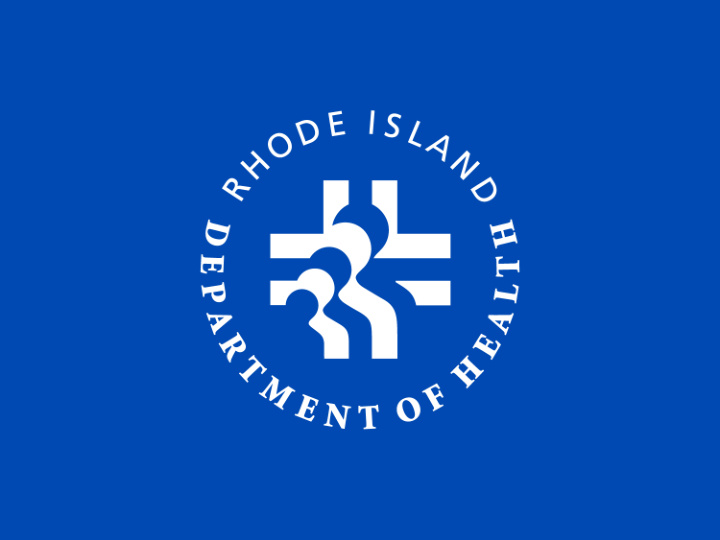



Luster Dust Bust Pulsenet/OutbreakNet West Coast Regional Meeting February 6 th , 2019 Brendalee Viveiros, MPH Principal Public Health Promotion Specialist Center for Food Protection Rhode Island Department of Health *Adapted slides from Genevieve Caron
Overview • Background • Environmental Health Investigation • About Luster Dust • Traceback Findings • Next Steps and Conclusions • Take Home Messages
About Rhode Island RI population 1.056 million Centralized Structure No LHDs 3 field offices State Health Lab and Health Department located in Providence EHS-Net State, RRT
Environmental Health Specialist Network (EHS-NET) • CDC Funded Grant that started in 2000 • Rhode Island became a partner in 2005 • Mission is to improve environmental health practices and prevent foodborne illness outbreaks
Environmental Health Specialist Network (EHS-NET) Strengthen collaboration among epidemiology, laboratory, and environmental health programs Identify contributing factors and environmental antecedents National Outbreak Reporting System (NORS) National Environmental Assessment Reporting System (NEARS) Translate findings to improve environmental health practices
Rhode Island Foodborne Illness Outbreak Investigation State Health Center for Food Laboratory (SHL) Protection (CFP) Center for Acute Infectious Disease Epidemiology (CAIDE)
Detection of Outbreak CAIDE received a call reporting that people became ill with vomiting after attending a 1 year old’s birthday party.
Epidemiology Investigation • Interviews: • 6 ill individuals (ages 1-11) • No other common events were identified • Exposures: the cake was a common item among all ill individuals, no well individuals consumed the frosting • Symptoms: vomiting, diarrhea • Onset: 30 minutes to 10 hours after consumption of cake • Duration: generally less than 10 hours
Rose Gold Cake • The cake was ordered from a RI bakery • The frosting on the cake was described as “metallic, glittery, and rose gold.” (pictured on right)
Environmental Health Investigation • Implement immediate control measures • Conduct a food flow of suspect item • NEARS Manager Interview • NEARS Environmental Observations
Food Flow • Looking at the suspect food item at every step in a restaurant system • Identify hazards • Identify poor practices • Collect evidence for contributing factors and environmental antecedents https://www.cdc.gov/nceh/ehs/ehsnet/system-theory.htm
Food Flow of Cake Ingredients: Cake Mix, Frosting, Luster dust? Cake is baked Cake is frozen Cake is frosted Cake is frozen Luster dust is added to butter extract and painted on cake with a brush in intervals to get nice thick layer
Luster Dust • An non-edible ingredient called Rose Gold Dust was applied as a decoration to the frosting of the cake in question. • This ingredient is also broadly known as a type of Luster Dust .
Control Measures • All non-edible Luster Dust bottles were placed under embargo – Some bottles were not clearly labeled as edible or non-edible – Luster dust without ingredients were considered non-edible • Identified other products that were for sale in the retail area that were coated with luster dust and embargoed. – Chocolate Pops – Pretzels with Chocolate
Luster Dust
Luster Dust AKA petal dust, pearl dust, sparkle dust, disco dust, highlighter dust…
Luster Dust Traceback
Luster Dust Traceback
Luster Dust Traceback
Luster Dust Traceback
Food Sampling CFP collected a leftover slice of cake from the party host’s residence for chemical testing by the SHL.
Food Sampling
Laboratory Findings Laboratory findings of the slice of cake: • 22.1 milligrams of copper per gram of Rose Gold- coated frosting • ~nearly 900 milligrams of copper on the slice of cake • A RIDOH toxicology specialist confirmed that these levels would have been sufficient to cause the symptoms that were described.
Conclusions • Symptoms and illness onsets were most consistent with a heavy metal poisoning • The cake frosting with luster dust was identified as the suspect food item: • It was decorated with a product that was not labeled for consumption • Contributing factor was identified as C3-poisonous substance accidently or inadvertently added as a result of misreading labels • Laboratory evidence supported this suspect etiology and identified copper as the metal associated with the poisoning.
Next Steps/Questions • What are other inedible luster dusts made of? • RIDOH sampled 28 other luster dusts and found: aluminum, barium, chromium, copper, iron, lead, manganese, nickel, and zinc. • Do other bakeries use these properly? • 1/3 of bakeries visited were using inedible luster dust on an edible part of a food • RIDOH issued guidance to bakeries • Edible glitters and dusts must have an ingredient list
FDA Guidance To Eat or Not to Eat: Decorative Products on Foods Can Be Unsafe To Eat or Not Too Eat: Decorative Products on Foods Can Be Unsafe
Take Home Messages • It’s a trend and “all bakers are using it” • There are edible glitters so its important to educate environmental health staff to identify the differences • Inedible luster dust is meant for decorations • Have there been other similar incidents? • Guidance to consumers and bakeries could potentially prevent another outbreak from happening
Thank you! Questions? Brendalee.Viveiros@health.ri.gov
Recommend
More recommend